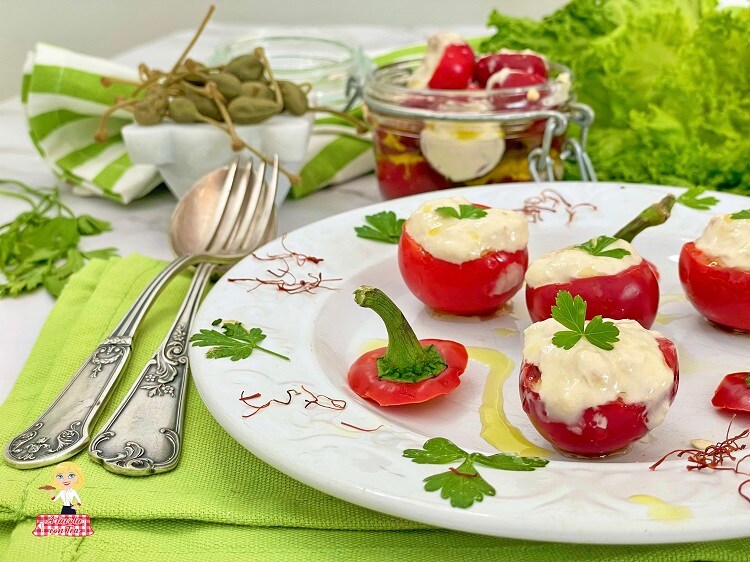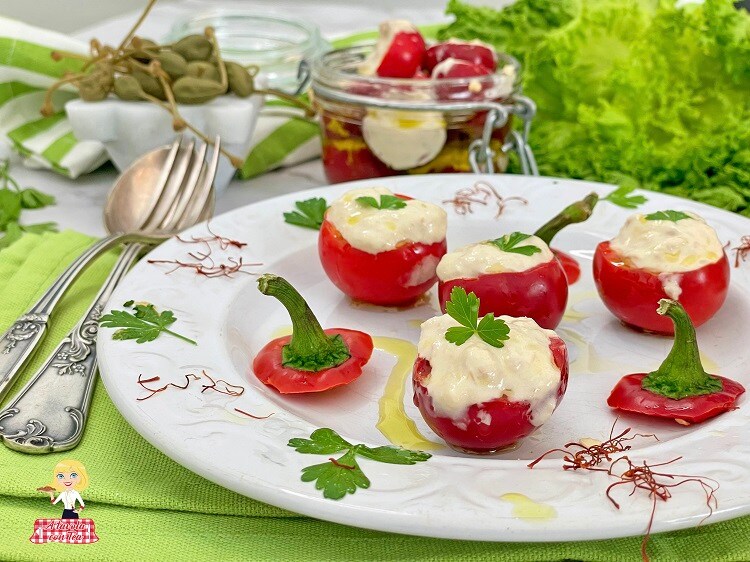Chili Peppers Stuffed with TUNA are the classic preserve that grandma used to make, simple yet delicious, with all the characteristic flavors of tradition to enjoy these little treats all year round.
These are spicy chili peppers in oil with a soft tuna filling flavored with capers and anchovies for a unique and intense taste.
An extremely easy recipe that can be prepared in no time and requires no particular kitchen skills, except a bit of patience because to best appreciate their flavor, it would be better to wait about twenty days… although I confess I can’t always manage that.
Chili Peppers Stuffed with TUNA are tasty and spicy, echoing all the typical flavors of the characteristic preparations from our grandmothers who, with their experience and skill, passed on to us the tradition of preserves, allowing us to enjoy out-of-season genuine products with a unique and intense flavor.
These little bright red treasures are great served with an aperitif or as an appetizer accompanied by crispy bruschetta, and despite the strong and peculiar taste, they are liked by practically everyone.
Chili Peppers Stuffed with Tuna are the classic rustic and homemade preserve that you can prepare with your own hands and, once ready, enjoy throughout the year.
As I already mentioned, to best appreciate them, it would take about twenty days, during which the chili peppers will gain flavor, but I recommend preparing an extra jar, as I do, for a “taste test” to check the quality!

- Difficulty: Very Easy
- Cost: Economical
- Rest time: 20 Days
- Preparation time: 20 Minutes
- Cooking time: 15 Minutes
- Portions: 2 jars 300 g
- Cuisine: Italian
- Energy 127.31 (Kcal)
- Carbohydrates 2.22 (g) of which sugars 1.15 (g)
- Proteins 7.32 (g)
- Fat 10.03 (g) of which saturated 1.52 (g)of which unsaturated 1.41 (g)
- Fibers 0.37 (g)
- Sodium 171.01 (mg)
Indicative values for a portion of 30 g processed in an automated way starting from the nutritional information available on the CREA* and FoodData Central** databases. It is not food and / or nutritional advice.
* CREATES Food and Nutrition Research Center: https://www.crea.gov.it/alimenti-e-nutrizione https://www.alimentinutrizione.it ** U.S. Department of Agriculture, Agricultural Research Service. FoodData Central, 2019. https://fdc.nal.usda.gov
Ingredients
- 1.1 lbs spicy chili peppers
- 14 oz tuna in oil
- 0.35 oz anchovies in oil
- 1 tbsp salted capers
- 2 1/2 cups water
- 1 1/4 cups white wine vinegar
- to taste bay leaves (optional)
- to taste extra virgin olive oil (to fill the jars)
Tools
- Small Pot
- Jars
Steps
First, wash the chili peppers and then clean them by cutting around the stem with a sharp-pointed knife and then twisting it off. Remove the seeds by gently scraping with the knife’s tip, then rinse them again to remove any remaining seeds.
Put water and vinegar in a pot and bring to a boil. Once boiling, add the chili peppers and cook for about 5 minutes from when it starts boiling again. After the time is up, turn off the heat, drain them, and let them dry on a towel upside down until completely cool (about 1 hour).
In the meantime, prepare the tuna filling. Drain the anchovies from their oil and chop them with a knife, desalinate the capers in cold water and chop them too, drain the tuna from its conservation oil and mash it with a fork. Combine the tuna, anchovies, and capers in a bowl and mix well. Finally, add a heaping tablespoon of mayonnaise and mix again.
Now that the chili peppers have completely cooled, take one at a time and fill them with the tuna filling using a teaspoon. Continue this way until all the chili peppers are filled. At this point, you could decide to eat them immediately by simply dressing them with a drizzle of olive oil, but I recommend waiting because resting improves them significantly.
Once the chili peppers are ready, place them in clean and sterilized glass jars, trying to keep them upright to prevent the filling from coming out. Then cover everything with plenty of extra virgin olive oil until they are completely submerged. If you do not plan to consume them the next day, sterilize the jars, and once completely cooled, store them in a cool place away from direct light for up to a month.

NOTES
I strongly recommend wearing disposable latex gloves before cleaning and preparing the chili peppers to avoid touching them with bare hands, as the peppers are very spicy and can irritate, especially if you touch your eyes.
I strongly recommend wearing disposable latex gloves before cleaning and preparing the chili peppers to avoid touching them with bare hands, as the peppers are very spicy and can irritate, especially if you touch your eyes.
PASTEURIZATION: when preparing preserves at home, it is absolutely necessary to proceed with the PASTEURIZATION process of oil-preserved foods at 176°F for at least 10 minutes. This additional heat treatment ensures the elimination of any botulinum toxins, which are much less heat-resistant than spores. For more information, read the article “Oil Preservation and Botulinum: Risks and Dangers”.
FAQ (Questions and Answers)
How to sterilize jars for oil preserves?
Start by adding two inches of water to the jars; microwave and heat until boiling; dump the water and let the jars rest upside down on a clean towel. Sterilization in the dishwasher: unlike the previous method, here you can sterilize both jars and lids.
How to sterilize jars without boiling?
To sterilize jars in the oven: turn on the oven to 212°F, insert the jars when it reaches temperature, turn off the oven after five minutes, and let the jars cool inside.

